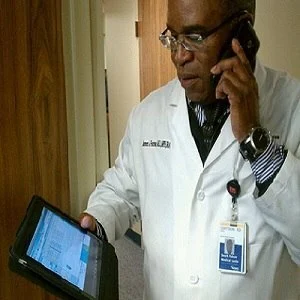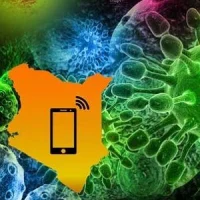Healthcare providers are turning to mobile technology to help them with efforts in reducing "preventable readmissions". A number of mobile apps that promote patient wellness and chronic disease management are already in use — eg, apps for monitoring patient blood pressure and blood sugar and those for tracking sleep.
While noting that "some readmissions are clinically appropriate and necessary," Cynthia Deyling, MD, chief quality officer at Cleveland Clinic, says hospitals can reduce preventable readmissions through improved patient education, follow up, communication and care coordination. Here, smartphones play a big role.
"We have apps in development that will support access by allowing patients to quickly identify local Cleveland Clinic resources, including on-demand scheduling," Dr. Deyling says.
A Mayo Clinic study has shown that patients who used smartphone apps to record weight and blood pressure — and participated in cardiac rehab — lowered cardiovascular risk factors and 90-day readmissions. In addition, 20 percent of the app-user patients experienced readmission compared to 60 percent of patients who completed rehab only.
Meanwhile, a new survey HIMMS conducted this year indicates "healthcare organisations are widely beginning to deploy mobile technologies with the aim of engaging patients." Use of mobile technology continues to interest providers as a way to meet requirements for meaningful use and Medicare reimbursement requirements, the survey shows.
The shift towards value-based payments drives efficient use of affordable, accessible technologies, such as mobile apps, according to Andrey Ostrovsky, MD, CEO of Boston-based Care at Hand, developer of an app-based care coordination system. "Our company wouldn't exist if not for Affordable Care Act," he points out.
Indeed, the rise in mHealth technologies correlates with ACA's plan to reduce preventable, excessive readmissions with cuts to the Inpatient Prospective Payment System in 2012. Each year, Medicare spends more than $17 billion on avoidable readmissions with penalties that total up to three percent of inpatient claims for 30-day readmissions.
However, according to the HIMSS survey, healthcare organisations "continue to struggle to effectively engage patients using existing mobile devices, noting that app-enabled portals allowed 73 percent of respondents to engage with patients, but that only 36 percent described that engagement as 'highly effective.'"
Many respondents reported "a need to fully optimise and leverage the wide capabilities that mobile technologies and platforms offered," according to the study.
That's what is being done at Cleveland Clinic. As Dr. Deyling points out: "We are beginning to have success using decision support tools in our EHR to ensure a patient is ready for discharge. These checklists ensure key activities, assessments, hand-offs and interventions take place. Technology that supports standardised, evidence-based care plays a role in preventing readmissions."
Source: HIMSS Media
Image credit: Flickr.com
While noting that "some readmissions are clinically appropriate and necessary," Cynthia Deyling, MD, chief quality officer at Cleveland Clinic, says hospitals can reduce preventable readmissions through improved patient education, follow up, communication and care coordination. Here, smartphones play a big role.
"We have apps in development that will support access by allowing patients to quickly identify local Cleveland Clinic resources, including on-demand scheduling," Dr. Deyling says.
A Mayo Clinic study has shown that patients who used smartphone apps to record weight and blood pressure — and participated in cardiac rehab — lowered cardiovascular risk factors and 90-day readmissions. In addition, 20 percent of the app-user patients experienced readmission compared to 60 percent of patients who completed rehab only.
Meanwhile, a new survey HIMMS conducted this year indicates "healthcare organisations are widely beginning to deploy mobile technologies with the aim of engaging patients." Use of mobile technology continues to interest providers as a way to meet requirements for meaningful use and Medicare reimbursement requirements, the survey shows.
The shift towards value-based payments drives efficient use of affordable, accessible technologies, such as mobile apps, according to Andrey Ostrovsky, MD, CEO of Boston-based Care at Hand, developer of an app-based care coordination system. "Our company wouldn't exist if not for Affordable Care Act," he points out.
Indeed, the rise in mHealth technologies correlates with ACA's plan to reduce preventable, excessive readmissions with cuts to the Inpatient Prospective Payment System in 2012. Each year, Medicare spends more than $17 billion on avoidable readmissions with penalties that total up to three percent of inpatient claims for 30-day readmissions.
However, according to the HIMSS survey, healthcare organisations "continue to struggle to effectively engage patients using existing mobile devices, noting that app-enabled portals allowed 73 percent of respondents to engage with patients, but that only 36 percent described that engagement as 'highly effective.'"
Many respondents reported "a need to fully optimise and leverage the wide capabilities that mobile technologies and platforms offered," according to the study.
That's what is being done at Cleveland Clinic. As Dr. Deyling points out: "We are beginning to have success using decision support tools in our EHR to ensure a patient is ready for discharge. These checklists ensure key activities, assessments, hand-offs and interventions take place. Technology that supports standardised, evidence-based care plays a role in preventing readmissions."
Source: HIMSS Media
Image credit: Flickr.com
Latest Articles
healthmanagement, mhealth, mobile apps, mobile technology, readmissions, EHR
Healthcare providers are turning to mobile technology to help them with efforts in reducing "preventable readmissions". A number of mobile apps that promote patient wellness and chronic disease management are already in use.










